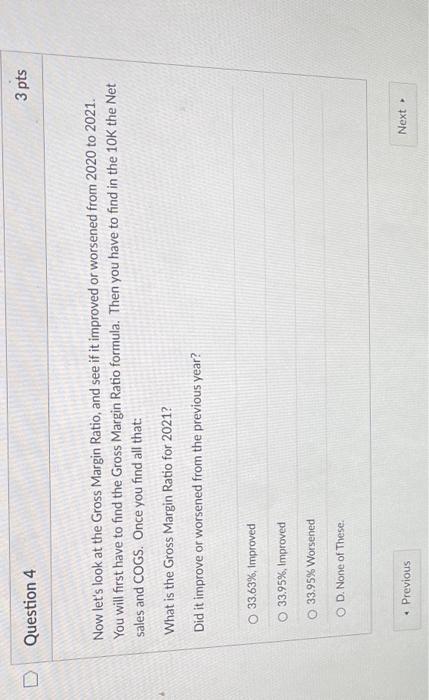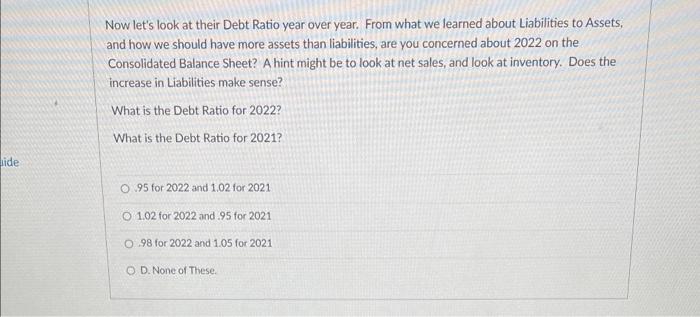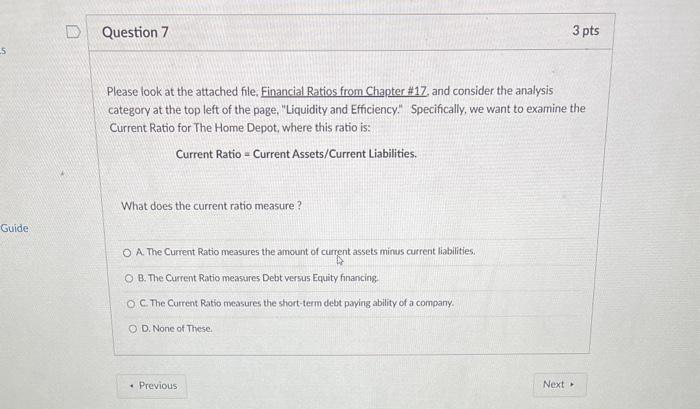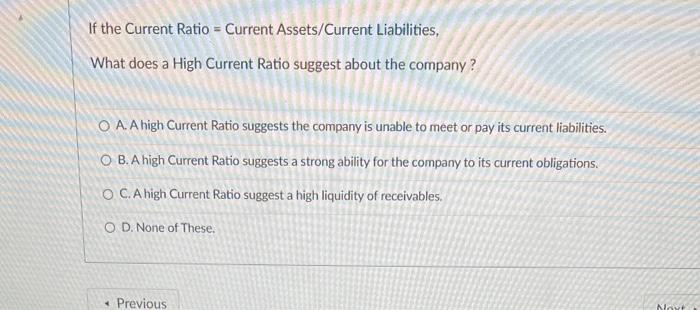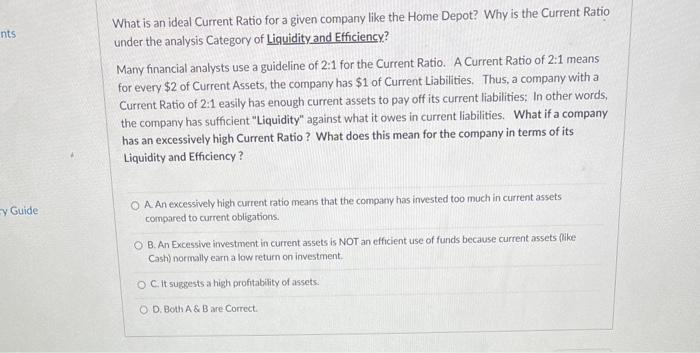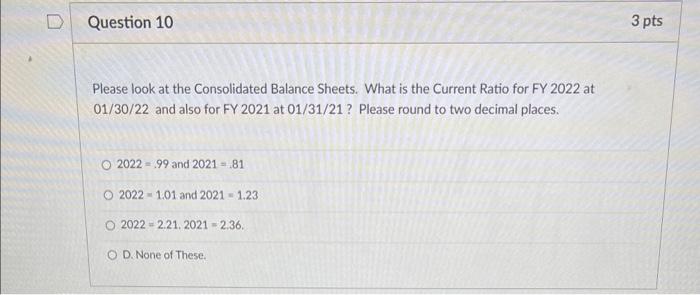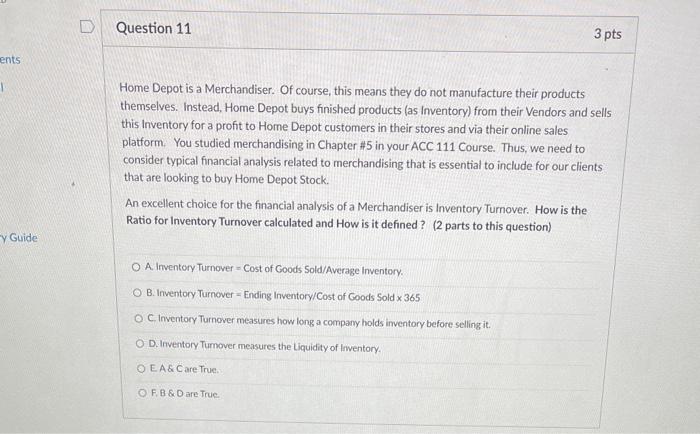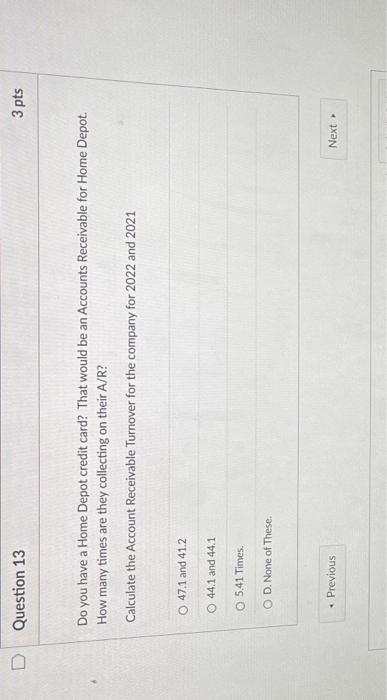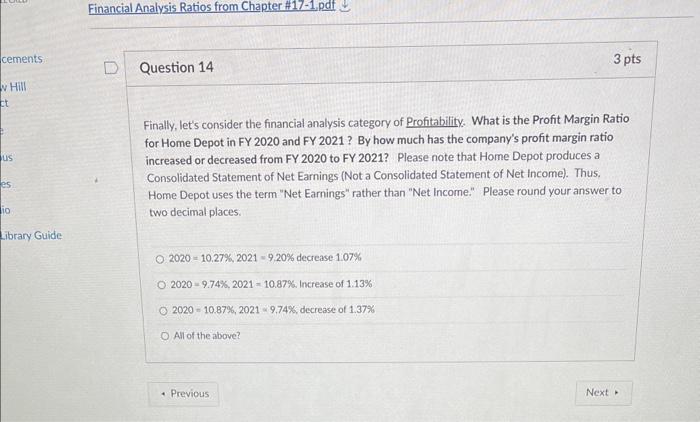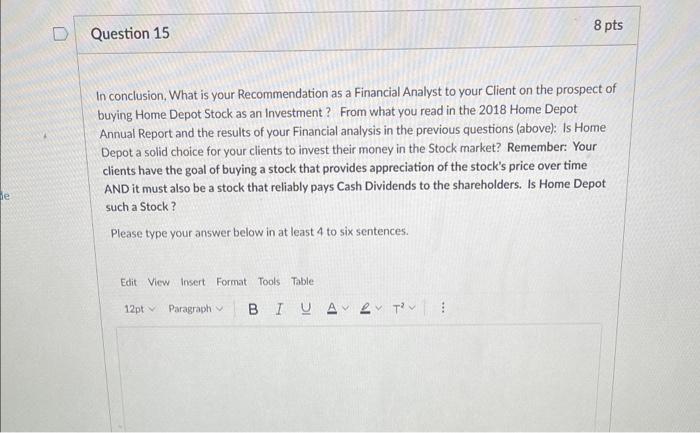Now let's look at the Gross Margin Ratio, and see if it improved or worsened from 2020 to 2021. You will first have to find the Gross Margin Ratio formula. Then you have to find in the 10K the Net sales and COGS. Once you find all that: What is the Gross Margin Ratio for 2021? Did it improve or worsened from the previous year? 33.63%, Improved 33.95%, Improved 33.95\% Worsened D. None of These. Now let's look at their Debt Ratio year over year. From what we learned about Liabilities to Assets, and how we should have more assets than liabilities, are you concerned about 2022 on the Consolidated Balance Sheet? A hint might be to look at net sales, and look at inventory. Does the increase in Liabilities make sense? What is the Debt Ratio for 2022 ? What is the Debt Ratio for 2021 ? 95 for 2022 and 1.02 for 2021 1.02 for 2022 and .95 for 2021 .98 for 2022 and 1.05 for 2021 D. None of These. Please look at the attached file, Financial Ratios from Chapter \#17, and consider the analysis category at the top left of the page, "Liquidity and Efficiency." Specifically, we want to examine the Current Ratio for The Home Depot, where this ratio is: Current Ratio = Current Assets/Current Liabilities, What does the current ratio measure? A. The Current Ratio measures the amount of current assets minus current liabilities. B. The Current Ratio measures Debt versus Equity financing. C. The Current Ratio measures the short-term debt paying ability of a company. D. None of These. If the Current Ratio = Current Assets/Current Liabilities, What does a High Current Ratio suggest about the company? A. A high Current Ratio suggests the company is unable to meet or pay its current liabilities. B. A high Current Ratio suggests a strong ability for the company to its current obligations. C. A high Current Ratio suggest a high liquidity of receivables. D. None of These. What is an ideal Current Ratio for a given company like the Home Depot? Why is the Current Ratio under the analysis Category of Liquidity and Efficiency? Many financial analysts use a guideline of 2:1 for the Current Ratio. A Current Ratio of 2:1 means for every $2 of Current Assets, the company has $1 of Current Liabilities. Thus, a company with a Current Ratio of 2:1 easily has enough current assets to pay off its current liabilities; In other words, the company has sufficient "Liquidity" against what it owes in current liabilities. What if a company has an excessively high Current Ratio? What does this mean for the company in terms of its Liquidity and Efficiency? A. An excessively high current ratio means that the company has invested too much in current assets compared to current obligations. B. An Excessive irvestment in current assets is NOT an efficient use of funds because current assets (like Cash) nocmally earn a low return on investment. C. it suggests a high profitability of assets: D. Both A&B are Correct. Please look at the Consolidated Balance Sheets. What is the Current Ratio for FY 2022 at 01/30/22 and also for FY 2021 at 01/31/21 ? Please round to two decimal places. 2022=.99 and 2021=.81 2022=1.01 and 2021=1.23 2022=2.21.2021=2.36 D. None of These. Home Depot is a Merchandiser. Of course, this means they do not manufacture their products themselves. Instead, Home Depot buys finished products (as Inventory) from their Vendors and sells this Inventory for a profit to Home Depot customers in their stores and via their online sales platform. You studied merchandising in Chapter \#5 in your ACC 111 Course. Thus, we need to consider typical financial analysis related to merchandising that is essential to include for our clients that are looking to buy Home Depot Stock. An excellent choice for the financial analysis of a Merchandiser is Inventory Turnover. How is the Ratio for Inventory Turnover calculated and How is it defined? (2 parts to this question) A. Inventory Turnover = Cost of Coods Sold/Average Inventory. B. Inventory Turnover = Ending Inventory/Cost of Goods Sold 365 C. Inventory Turnover measures how long a company holds inventory before selling it. D. Inventory Turnover measures the Liquidity of lewentory. EA A C Care True. F, B&D are True. Now look at the financial sheets in this 10K and calculate the Inventory Tumover. This might be a good indicator of how business is doing, right? Calculate the Inventory Turnover for 2020 and 2021. You should find what you need in both the consolidated income statement and the consolidated balance sheet. How many times did Home Depot turn over their inventory in 2020 and in 2021? 19 times in 2021 and 22 times in 2020 4.55 in 2021 and 5.25 in 2020 5.19 times in 2021 and 4.51 times in 2020 None of the above Do you have a Home Depot credit card? That would be an Accounts Receivable for Home Depot. How many times are they collecting on their A/R ? Calculate the Account Receivable Turnover for the company for 2022 and 2021 47.1 and 41.2 44.1 and 44.1 5.41 Times. D. None of These. Finally, let's consider the financial analysis category of Profitability. What is the Profit Margin Ratio for Home Depot in FY 2020 and FY 2021 ? By how much has the company's profit margin ratio increased or decreased from FY 2020 to FY 2021? Please note that Home Depot produces a Consolidated Statement of Net Earnings (Not a Consolidated Statement of Net Income). Thus. Home Depot uses the term "Net Earnings" rather than "Net Income." Please round your answer to two decimal places. 2020=10.27%,2021=9.20% decrease 1.07% 2020=9.74%,2021=10.87%. Increase of 1.13% 2020=10.87%,20219.74%, decrease of 1.37% All of the above? In conclusion, What is your Recommendation as a Financial Analyst to your Client on the prospect of buying Home Depot Stock as an Investment? From what you read in the 2018 Home Depot Annual Report and the results of your Financial analysis in the previous questions (above): Is Home Depot a solid choice for your clients to invest their money in the Stock market? Remember: Your clients have the goal of buying a stock that provides appreciation of the stock's price over time AND it must also be a stock that reliably pays Cash Dividends to the shareholders. Is Home Depot such a Stock? Please type your answer below in at least 4 to six sentences
